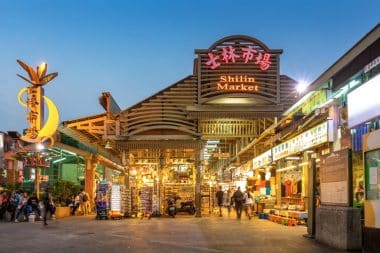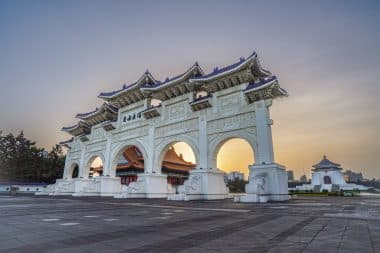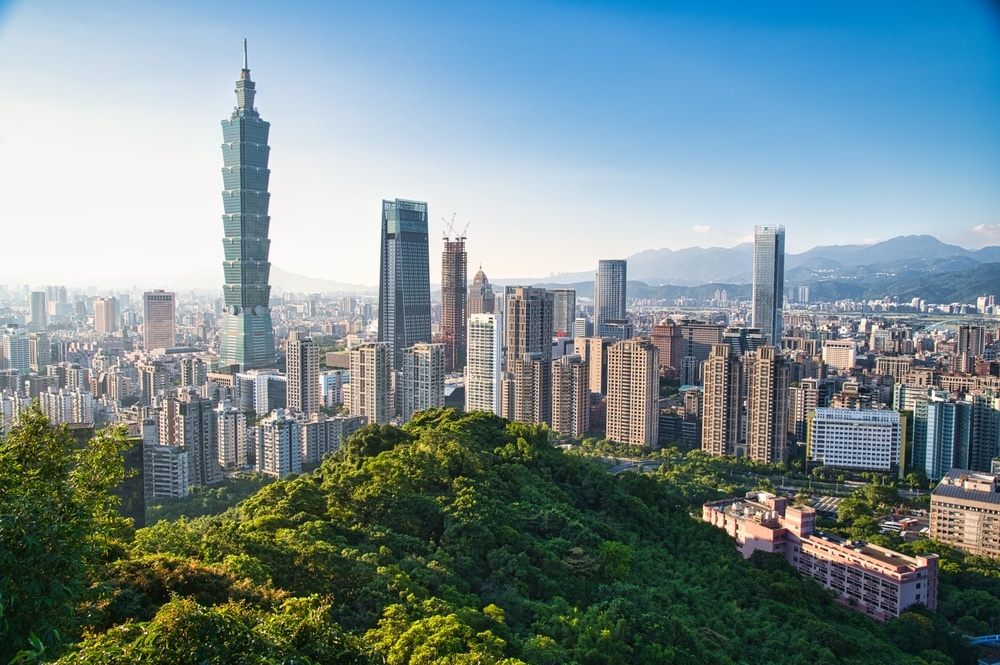Taipei, the vibrant capital of Taiwan, occupies a prominent position in the country. It is the economic, political and cultural centre of the country. Over 2.4 million people live in the city, which was founded in the early 18th century by Chinese immigrants in the north of the island. Taipei inspires with a fascinating mix of tradition and modernity and has retained its cultural and historical identity despite its futuristic skyline. The warm hospitality of Taiwanese people and the unique location between the Keelung and Danshui Rivers add to the city’s unique charm. Taipei is considered one of the safest cities in the world.
Discover the Heart of Taiwan – Taipei’s Fascinating Sights
Taipei 101 – A Masterpiece of Architecture and Technology
Taipei 101, named after its 101 floors, is a symbol of Taiwan’s innovation and modernity. With a height of 508 meters, the building rises majestically above the skyline of Taipei. The structure, made of 44,000 tons of steel and concrete, was once the tallest building in the world and remains an architectural marvel today. The observation deck on the 89th floor is located at 392 meters and offers a spectacular panoramic view of Taipei’s skyscraper sea. A fascinating feature of the Taipei 101 is the 660-ton “Damper Swing” pendulum ball, which helps reduce the building’s vibrations during earthquakes and storms.
Shilin Night Market – Taipei’s Culinary Paradise

No trip to Taiwan is complete without a trip to one of the famous night markets. And no other market is as legendary as the Shilin Night Market in Taipei. It is located in the Shilin district and is the largest of its kind in the city. The Shilin Night Market is a maze of alleys lined with countless shops and stalls. Here you can stroll through the lively streets, watch the hustle and bustle and discover the culinary delights of Taiwan. The atmosphere is electric and welcoming, with tourists and locals haggling over the stalls. From traditional street food to fashionable accessories, there is something for everyone here. Jiantan Metro Station is close by.
Chiang Kai-Shek Memorial Hall – A place of reverence and reflection
Amid the hustle and bustle of Taipei, the imposing Chiang Kai-Shek Memorial Hall rises as a place of rest and reverence. The almost 25-hectare memorial is dedicated to the former President of the Republic of China, Chiang Kai-Shek. The bright blue roof, designed in the style of the Altar of Heaven in Beijing, and the torso, reminiscent of an Egyptian pyramid, give the building its awe-inspiring, majestic appearance. Upon entering the main hall, visitors are greeted by an imposing bronze statue of the late president. In the basement, a captivating exhibition provides information about his life and work. The magnificent white marble building is surrounded by tranquil landscaped gardens, graceful pavilions and tranquil pond landscapes. The memorial is flanked by the National Theatre and the Concert Hall, which are built in the classical Chinese style. Cultural events by Taiwanese or foreign artists and ensembles are regularly held here.
Elephant Mountain – breathtaking hike to the most famous viewpoint

In the middle of the urban jungle of Taipei, a natural jewel, the Elephant Mountain, rises majestically. The stairs to the 170-meter-high Xiangshan Mountain are a real challenge. The climb is steep and alternates between extremely low and extremely high levels. About 500 steps lead to the Rock Viewing Point. After another 100 steps you reach the covered viewpoint. The hike takes about 30 minutes. The trailhead is 1.5 kilometers from Taipei 101 and only 1,000 meters from Xiangshan MRT Station. Elephant Mountain offers spectacular views of the city’s glittering skyline. At the summit there is a place of peace, reflection and connection with nature.
Taipei’s Infinite Diversity – More Unique Sights
- Dalongdong Baoan Temple – Beautiful temple from the Qing Dynasty.
- Hsing Tian Kong – Important Taoist temple with a spiritual atmosphere.
- Lungshan Temple of Manka – Historical Buddhist temple.
- National Palace Museum – Treasure house of Chinese art and culture, with an impressive collection of ancient artifacts and treasures.
- Presidential Palace Office Building – Important historical and political landmark.
- Ximending – Lively shopping district with colorful hustle and bustle and cultural diversity.
- Dihua Street and Dadaocheng Districts – Historic districts with traditional buildings, antique shops and lively markets.
- Tachiao Church – Picturesque church with fascinating architecture.
- Graffiti Lane – Colorful alleys decorated with impressive graffiti artwork.
- Jiufen – Charming mountain village high above the northeastern coast, known for its picturesque scenery, traditional architecture and delicious street food, especially the “Old Street” with its red lanterns and traditional tea houses offers an unforgettable experience.
Comfortable and efficient travel through Taipei by metro
Since its inception in 1996, the Taipei Metro has become an integral part of the city’s transportation network and the ideal mode of transportation for visitors. The extensive route network with numerous lines makes it easy to reach every corner of the city. The Taipei Metro (MRT) is known for its immaculate cleanliness and punctuality. Eating and drinking within the stations and trains is prohibited and passengers receive the exact departure and arrival times via real-time updates.
When Taiwan is at its most beautiful – the best time to travel
The best time to visit Taiwan is from March to May and from October to December. During these periods, temperatures are mild and pleasant, humidity is lower and there is less rain. These times also include many cultural festivals and events in Taiwan. The summer from June to August is typhoon season. Then it can get very hot and humid, especially in the coastal regions. Winter from December to February is usually mild and pleasant in the south, but cool and rainy in the north. There may be snowfall in the mountains.


